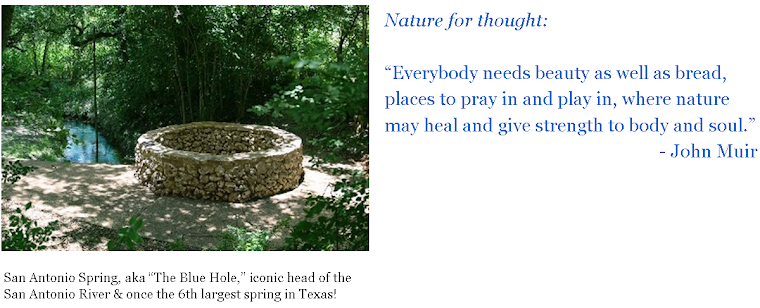According to Gunter Brune, who wrote the book on the Springs of Texas, San Antonio Springs was once the 6th largest in Texas. It is (was) one of the “Great Springs of Texas” that issue forth from the vast underground water source we call the Edwards Aquifer. Other “Great Springs of the Edwards Aquifer” include Comal Springs in New Braunfels (1st); San Marcos Springs in San Marcos (2nd); Goodenough Springs, now under Amistad Reservoir (3rd); San Felipe Springs in Del Rio (4th); Barton Springs in Austin (5th); and historically, San Antonio Springs (6th).
Sadly, there are now many months when the San Antonio Springs are dry due to over-pumping of the aquifer and radical changes in the land use and thus hydro-geology of the area.
But in the glory days, the San Antonio Springs inspired grown men to flights of fancy, as seen in these words of Fredrick Law Olmstead, designer of Central Park in New York City, who visited the springs in 1857 and described them in this way:
“The San Antonio Spring may be classed as the first water among the gems of the natural world. The whole river gushes up in one sparkling burst from the earth. It has all the beautiful accompaniments of a smaller spring, moss, pebbles, seclusion, sparkling sunbeams, and dense overhanging luxuriant foliage. The effect is overpowering. It is beyond your possible conceptions of a spring. You cannot believe your eyes, and almost shrink from sudden metamorphosis by invading nymphdom.”
At times, the San Antonio Springs still gush up from the earth into the Blue Hole in a clear, sparkling burst that flows out of the well to become the San Antonio River. It is soon joined by the waters of Olmos Creek, which is itself fed by many springs large and small.
Collectively, we call this area the “Headwaters Basin” because it is chock full of springs that emerge when the water table in the aquifer rises high enough. It becomes leaky land, with springs popping up in basements and underground parking garages and under ball fields. It is no wonder that the area has been so attractive to humans since prehistoric times!
Clean, clear, abundant water, a rich variety of plants and animals, natural beauty in a favorable climate – this is a good place to call “home,” as the Sisters of Charity have done for over one hundred years. And it is a good place to visit: to walk in nature, peep into the aquifer, enjoy the wonders of God’s creation, and contemplate our role – past, present and future -- in the stewardship of these sacred lands and waters at the “Head of the River.”



